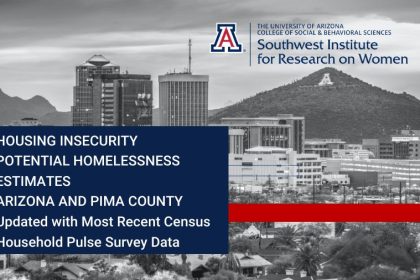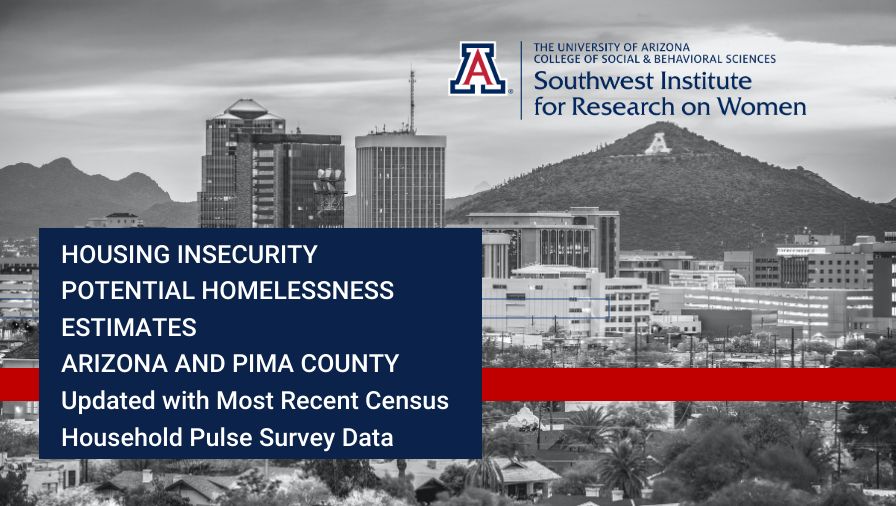

The University of Arizona Southwest Institute for Research on Women has released its most recent update to its report on Housing Insecurity Indicators and Potential Homelessness Estimates for Arizona and Pima County. This report measures current housing insecurity with newer census data.
This most recent survey wave contains multiple positive developments:
- The positive macroeconomic situation has continued to hold steadily at both the national and state levels.
- The unemployment rate in Arizona, 3.8% in March 2024, is a modest decrease relative to 4.1% in February and remains below historical averages.
- In the previous survey wave, collected February 6th-March 4th 2024, the proportion of non-current renters in Arizona was 6.3%. In the most recent survey, conducted March 5th-April 1st 2024, this proportion rose very slightly to 6.7%.
- The proportion of these non-current renters viewing eviction in the next two months as “very likely” remained very low at 8.5% (9.9% last survey wave).
Throughout all of 2023 housing insecurity among Arizona renters remained stubbornly high despite historically low unemployment.
- These last two survey waves contain the first clear signals that the breadth of housing insecurity in Arizona is easing substantially. That said, lower-income and BIPOC Arizona households remain disproportionately likely to report being not current on their rent payments and finding it very difficult to meet usual expenses.
- The National Equity Atlas estimated that 79% of non-current renters in Arizona are POC and 75% are low-income (based on the Census HPS data wave collected Jan 9th-Feb 5th 2024).
- Mortgage holders in Arizona continue to be in a strong financial position relative to renters.
- Only 4.2% reported being not current on mortgage payments (down slightly from 5.3% last wave).
- Although among this small share of non-current mortgage holders concern about the likelihood of foreclosure in the next two months increased this wave to 16% from only 1% last wave.
- Among non-current Arizona renters, the depth of rental debt has decreased.
- This most recent survey indicates that, among Arizona renters who are behind on their rent, 66%, are only behind on their payments 1 month or less.
- And 71% of non-current Arizona renters were only 2 months behind on rent or less.
- In the fall of 2022 Tucson rent prices began decreasing on average, albeit very modestly.
- In the Spring of 2023 rent prices in Tucson registered modest upticks in median/average rent prices. Despite these increases, seasonally adjusted metrics of Tucson rent prices increased only 3.5% between April 2023 and April 2024.
- This is a substantial slowdown in the rate of rental price increases we have seen in recent years.
- In addition, there is unambiguous good news in the rental vacancy rate, which has been trending upwards since the end of 2021, and hit an 8-year high in the 1st quarter of 2024. However, countervailing signals worth attention include:
- only 51% of all Arizona respondents reported they had not experienced pressure to move in the last 6 months, down from 62% of respondents reporting no pressure last wave.
- 67% of Arizona renters reported an increase in their monthly rent in the last year (up from 57% last survey wave) and 50% reported an increase of $100 or more (up from 43% last wave).
The most significant development in this report is that eviction filings have fallen substantially since January and suggest a substantial easing of housing insecurity among Pima County renters.
- Relative to a peak of 1307 eviction filings in January of 2024, the count of eviction filings fell 41% to 771 in April. We have not seen the monthly count of eviction filings this low since November of 2021.
Other metrics suggest continuing reason for concern:
- 12% of Arizona households reported reducing or not paying expenses for basic household necessities (such as medicine or food) “almost every month” in the last 12 months to pay an energy bill (66% of households reported “never” being in this situation).
- Credit card debt balances nationwide and in Arizona have increased 33% between Q4 2022-Q4 2023.
- And since November of 2023, counts of calls to 211 from Pima County indicate a very substantial increase in calls related to housing and shelter and utilities in recent months.

